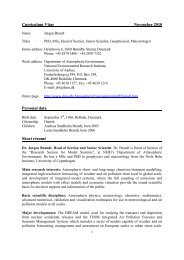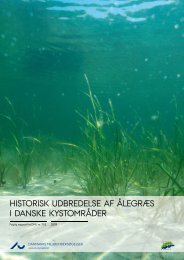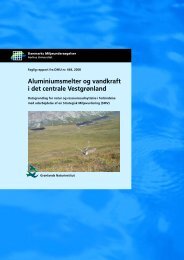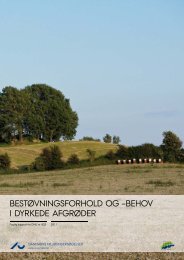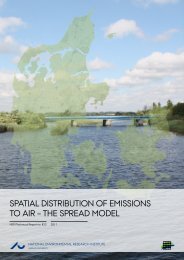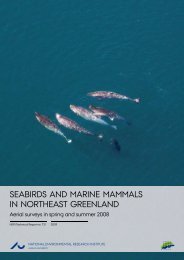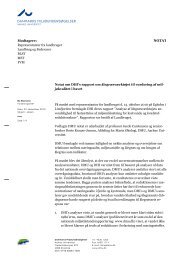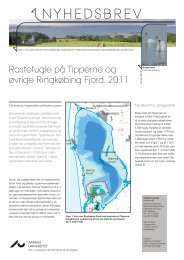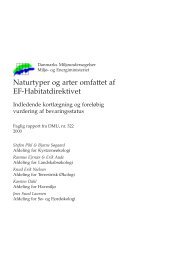- Page 1:
Natur- og Miljøforskningskonferenc
- Page 6:
Datablad Titel: Natur- og Miljøfor
- Page 10:
Bestemmelse af Søers Historiske Ud
- Page 14:
Luftforureningsudsigter og trafiksc
- Page 20:
Session 1 Biodiversitet og naturkva
- Page 26:
antal flyvefærdige unger 500 450 4
- Page 30:
Formålet med de omfattende feltund
- Page 36:
Kan vi forudsige sandsynligheden fo
- Page 40:
Naturen i det agrare landskab - et
- Page 44:
Naturplaner som metode til at ident
- Page 48:
Naturkvalitet i strandenge, moser o
- Page 52:
Tranberg, H. & Vinther, E., 2000: V
- Page 58:
indfundet sig. Evaluering og valide
- Page 64:
Genetiske aspekter af habitatfragme
- Page 68:
DanBIF -Danmarks nationale knudepun
- Page 72:
Session 2 Natur og miljø i søer o
- Page 76: Nitrat i vand under skove Per Gunde
- Page 80: Fosfor i åer, søer og fjorde: Hva
- Page 84: Referencer Kronvang, B., Iversen, H
- Page 90: hvad der fjernes med afgrøderne. J
- Page 94: oversætte de fysisk-kemiske vilkå
- Page 98: Habitater i vandløb Forskellene er
- Page 102: Kobling af hydrauliske vandkvalitet
- Page 108: Restaurering af Furesøen Morten Je
- Page 112: Udsætning af geddeyngel som redska
- Page 116: Benthisk og pelagisk mikroalgeprodu
- Page 120: Brakvandssøer: struktur og funktio
- Page 124: POSTER Bestemmelse af Søers Histor
- Page 136: POSTER Lake restoration by aluminiu
- Page 144: POSTER Multivariate analysis of phy
- Page 152: POSTER Grødeskæring reducerer inv
- Page 156: Session 3 Økotoksikologi og risiko
- Page 160: Assessing risks of chemicals to eco
- Page 166: Brugen af biomarkøren på regnorm,
- Page 170: 2 4 5 16 3 1 7 11 8 9 10 19 6 21 22
- Page 174: Acartia-testen blev desuden anvendt
- Page 180:
”Baltic Carrier” oliekatastrofe
- Page 184:
DNA skader - et vigtigt effektmål
- Page 188:
En ny metode til prioritering af op
- Page 192:
Effekt af metalforurening på regno
- Page 196:
Udvaskning af glyphosat og metribuz
- Page 202:
analyseret indholdet af forskellige
- Page 208:
Pesticider i vandløb og søer: kon
- Page 212:
Forekomst af pesticider i 24 vandhu
- Page 216:
En undersøgelse spildevands hormon
- Page 220:
Bortrensning af steroidøstrogener
- Page 224:
Økotoksikologiske effekter af kemi
- Page 228:
POSTER Plantebiomarkørmønster - V
- Page 232:
Physical stress Abiotic stress Chem
- Page 236:
Screeningsprogrammet Screeningsprog
- Page 240:
POSTER Plantebiomarkørmønster - V
- Page 244:
POSTER Videoregistrering af subleth
- Page 248:
POSTER Bromerede flammehæmmere - t
- Page 252:
Dinan L., Bourne P., Whiting P., Dh
- Page 256:
Session 4 Natur og miljø i fjord o
- Page 260:
Marin økotoksikologi - baggrund og
- Page 264:
Polycykliske aromatiske hydrocarbon
- Page 268:
Bundfaunasammensætning afslører m
- Page 272:
Metode til biologisk screening af r
- Page 276:
Vidensopsamling til beslutningstage
- Page 280:
Dyreliv på havbunden nu og for 100
- Page 284:
Reduktioner af næringsstofsbelastn
- Page 288:
Fyns Amt (2002). Kystvande 2001. Kr
- Page 292:
Påvirkning af stofomsætningen i h
- Page 296:
Overvågning og forvaltning af euro
- Page 300:
Kvælstofdeposition til danske farv
- Page 304:
POSTER Danmarks Marine Datakort Kar
- Page 308:
POSTER AQUABASE - marinbiologisk da
- Page 312:
POSTER Næringssaltbegrænsning af
- Page 316:
Session 5 Luft, miljø og sundhed P
- Page 320:
De nye EU direktiver om luftkvalite
- Page 324:
Fremskrivningsmodeller for luftemis
- Page 328:
Use of exposure simulation models a
- Page 332:
Modellering af personlig eksponerin
- Page 336:
Referencer Jensen, S.S., Berkowicz,
- Page 340:
DEHM - et modelværktøj til vurder
- Page 344:
Luftforureningsudsigter og trafiksc
- Page 348:
Eksponering for luftforureningskomp
- Page 352:
Helbredseffekter af partikulær luf
- Page 356:
Hvordan beskriver vi partikelforure
- Page 360:
Luftforurening og akut sygelighed i
- Page 364:
POSTER Personlig eksponering for fi
- Page 368:
POSTER Akkumulering af atmosfærisk
- Page 372:
POSTER Afdrift og fordampning af 10
- Page 376:
Session 6 Effekter af globale milj
- Page 380:
Modelsimuleringer af atmosfærisk C
- Page 384:
Kulstofbinding i skov- og landbrugs
- Page 388:
Towards the systematic use of marin
- Page 392:
Regionale simuleringer af drivhusef
- Page 396:
Modellering af de økologiske konse
- Page 400:
Interaktioner mellem forurening og
- Page 404:
Konsekvenser af vejr- og klimaforan
- Page 408:
UV-B strålingens betydning for den
- Page 412:
Konsekvenser af klimaændringer for
- Page 416:
Konsekvenser af klimaændringer for
- Page 420:
POSTER Dansk tilpasning til et ænd
- Page 424:
POSTER Ændret klima vil påvirke v
- Page 428:
POSTER Hedeøkosystemet er sensitiv
- Page 432:
POSTER Plantefysiologiske effekter
- Page 436:
CO2-assimilationsmålingerne viste
- Page 440:
POSTER Hvad betyder den atmosfæris
- Page 444:
POSTER Klima og fødekæder i Arkti
- Page 448:
POSTER Sea level rise in Denmark -
- Page 452:
Session 7 Miljøøkonomi, miljøsoc
- Page 456:
Borgerdeltagelse på miljøområdet
- Page 460:
Dekker, K.; M. Diani; A. Jamison; L
- Page 464:
Mobilitet og miljø Mette Jensen Da
- Page 468:
Miljømærknings betydning for forb
- Page 472:
Natur og miljøforvaltning baseret
- Page 476:
Towards a holistic assessment and c
- Page 480:
Prioritering af miljøindsats Peter
- Page 484:
Værdisætning af pesticidanvendels
- Page 488:
Nyt økonomisk værktøj til regule
- Page 492:
Økonomisk værdisætning af de sam
- Page 496:
Regionale fordelingsvirkninger af m
- Page 500:
Videnskab og politik - om vilkåren
- Page 504:
POSTER Biodiversitetsbeskyttelse og
- Page 508:
De biologiske data er baseret på l
- Page 512:
Program for Natur- og Miljøforskni
- Page 516:
Torsdag den 22. august 2002 kl. 13:
- Page 520:
Torsdag den 22. august 2002 kl. 13:
- Page 524:
Fredag den 23. august 2002 kl. 10:5
- Page 528:
Fredag den 23. august 2002 kl. 9:00
- Page 532:
Fredag den 23. august 2002 kl. 9:00
- Page 536:
Forfatter index Adsersen, Anne.....
- Page 540:
Jeppesen, Erik, ej@dmu.dk .........
- Page 544:
Konferencen Amterne og Danmarks Mil





